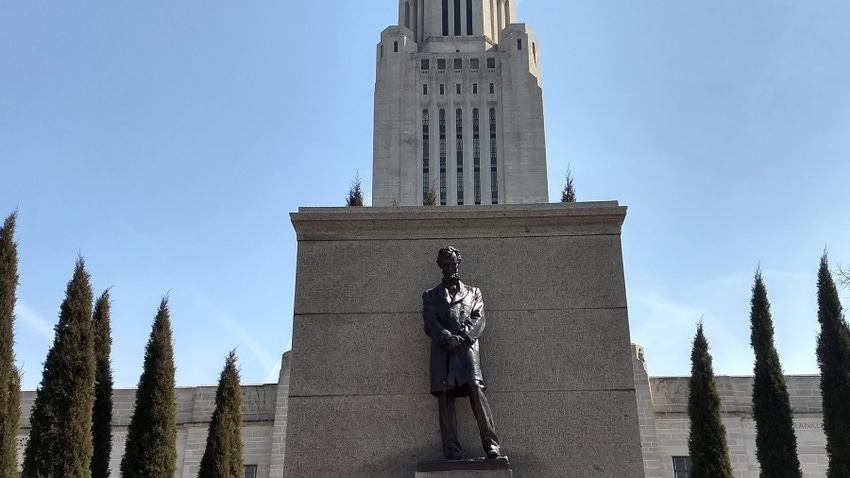
Old Abe deserves some appreciation from farmers, especially on his birthday.
Abraham Lincoln, the 16th U.S. president, never had a federal holiday solely honoring his birthday or legacy. Lincoln was born in a log cabin on Feb. 12, 1809, on Sinking Spring Farm in LaRue County, Ky.
While many states honored Lincoln’s birthday with their own state holidays, his contributions to the nation are now honored — along with George Washington and all the other presidents — on Presidents Day, the third Monday in February.
Many schoolchildren from decades ago might recall Lincoln’s birthday as a special day in their classrooms — studying about Lincoln’s life, perhaps memorizing his famous Gettysburg Address, or creating drawings of Lincoln or his birthplace, that cabin in Kentucky.
Today, the Lincoln birthday remembrance is a bit watered down with Presidents Day festivities a week later on the calendar.
Contributions still evident
Nebraska farmers should honor Lincoln, as well, for his contributions to agriculture in the state and around the nation, many of which continue to reverberate today. Lincoln only glimpsed Nebraska soil once in his lifetime, and he never set foot into Nebraska Territory.
By August 1859, Lincoln was a well-known national politician, thanks to his unsuccessful run for U.S. Senate and his famous debates against Democratic rival, Stephen Douglas, in 1858. He lost that election, but his name had already been whispered among his friends for the U.S. presidency.
During a visit to Council Bluffs, Iowa, that August, he stepped onto a high hill and viewed for the first time the Missouri River and the land across that river into Nebraska Territory, which was established through the 1854 Kansas-Nebraska Act.
Lincoln was thinking ahead about Nebraska’s Platte River Valley as a route for the proposed transcontinental railroad.
More than the Civil War
After being elected president in 1861 and becoming involved in the operations of the bloody and horrific Civil War, Lincoln still found time to encourage, promote and sign legislation that would shape Nebraska and the West forever.
Here are just a five of those major accomplishments that affected agriculture and Nebraska:
1. Pacific Railroad Act. Signed by Lincoln in June 1862, this law paved the way for the development of the transcontinental railroad that eventually took the Platte River Valley route across Nebraska. It was completed in 1869, after Lincoln’s death.
2. Homestead Act. After the act passed in 1862, Daniel Freeman became what is considered the first official homesteader in the nation, when he claimed 160 acres of land near what is now Beatrice, Neb., at 12:10 a.m. on the same morning the law took effect, Jan. 1, 1863. His homestead is now Homestead National Historical Park along Highway 4.
3. Morrill Land-Grant College Act. Signed into law on July 2, 1862, this legislation provided 30,000 acres of federally owned land for each senator and representative of that state, in order to establish colleges and universities, like the University of Nebraska, to teach agriculture.
4. Department of Agriculture Act. The U.S. Department of Agriculture was designated by Lincoln on May 15, 1862, when he signed the legislation into law. In his last annual message to Congress, Lincoln referred to USDA as the “people’s department.” Isaac Newton was the first U.S. commissioner of agriculture. Four Nebraskans would eventually serve in that post as USDA secretary, including J. Sterling Morton (administration of Grover Cleveland, 1893-97); Clifford Hardin (Richard Nixon, 1969-71); Clayton Yeutter (George H.W. Bush, 1989-91) and (Mike Johanns (George W. Bush, 2005-07).
5. Last official act. While attending a play at Ford’s Theater in Washington, D.C., on the evening of April 14, 1865, just after the Civil War had come to completion, Lincoln was assassinated by John Wilkes Booth and died in the early-morning hours the following day. Very few people know, however, that among the items found on his desk at the White House after he was shot was a certificate naming Alvin Saunders at the territorial governor of Nebraska. So, the naming of Saunders was among Lincoln’s last official acts as president.
Lincoln’s legacy in Nebraska is honored in many ways, not the least of which is the naming of the state capital city.
As many stand at the base of the massive 1912 bronze statue of Lincoln along the West Plaza of the State Capitol building, it is right that farmers and rural state legislators, in particular, reflect on his contributions not only on the national stage in ending slavery and bringing a successful end to the Civil War, but also the additional steps he took that continue to affect the state’s farmers and ranchers today.
About the Author(s)
You May Also Like






